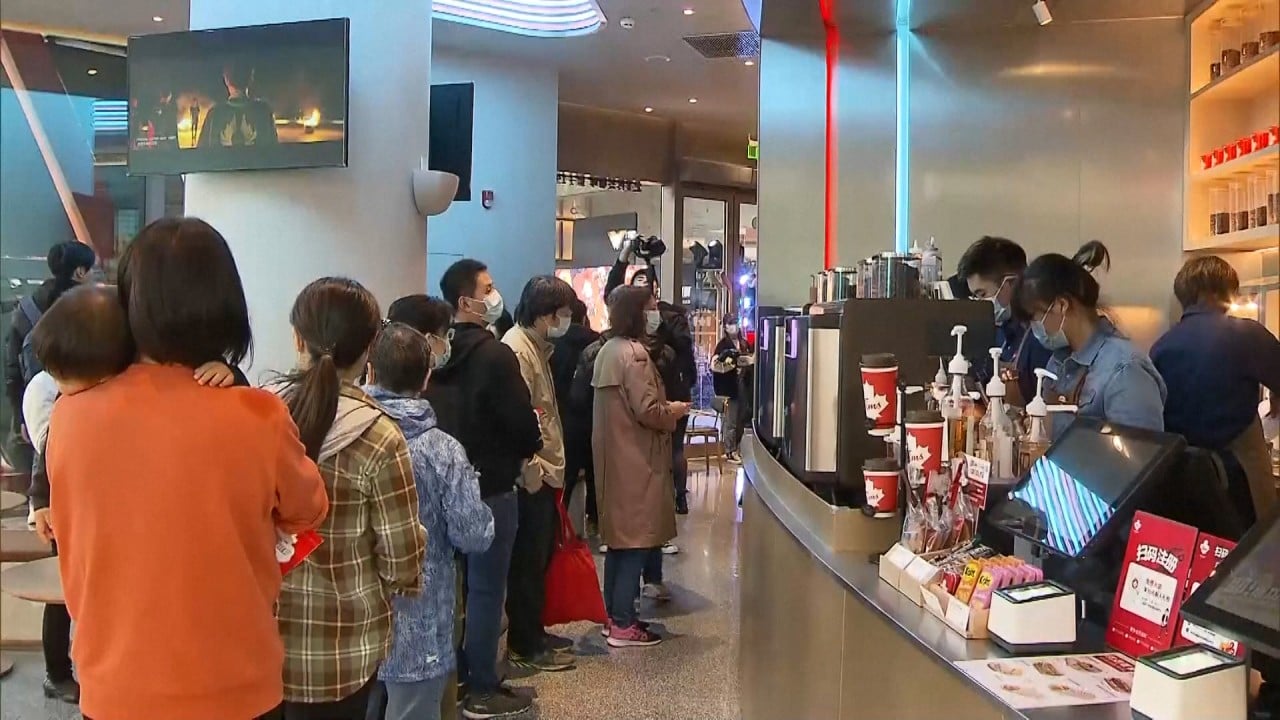
Chinese feel imported inflation pressure, from coffee to crude to cosmetics
- Price hikes at major coffee chains such as Starbucks and Luckin set off a social media firestorm, illustrating public gripes over inflation as Chinese consumers see own wages fall
- Analysts say outcry is an indication that Chinese consumers have turned more sensitive to inflationary pressures in a difficult economic climate
As American consumers from New York to San Francisco are sipping the most expensive coffee in a decade, China’s middle class is finding that surging bean prices have left a bitter taste in their mouths.
Many white-collar workers in big Chinese cities, who have taken a cue from Western drinking habits and made China one of the fastest-growing markets for coffee, are now lamenting the rising cost of socialising with friends and business partners in cafes.
And their complaints are echoing across Chinese social media. Last Wednesday, the rising price of coffee was the most discussed topic on Weibo, China’s equivalent of Twitter with more than half a billion registered users.
Their ire appears to be directed largely at major coffee chains, including Starbucks. At its locations in Beijing, a “grande” Americano now costs 30 yuan (US$4.73) after a recent 7.1 per cent price hike. Its competitors, such as Tim Hortons and domestic brand Luckin Coffee were also called out for their hikes.
‘More pro-growth policies’ expected to help boost China’s economy
Data showed that Weibo posts about the rising prices had garnered hundreds of millions of views.
“In contrast to the rise of food, accommodation and commuting prices, salaries are falling … As a wage earner, I can’t see any hope,” one user wrote.
Analysts say that the outcry is an indication that Chinese consumers have turned more sensitive to inflation amid the tough economic situation, and that Beijing, which has long been accused of exporting inflation via its massive supply of consumer goods globally, could also face imported inflation.
About half of China’s demand for coffee beans is met through imports, and those prices are largely decided by international markets.
In the past 12 months, the Coffee C Futures price, a benchmark for commodity-grade Arabica coffee on the New York International Commodity Exchange, rose to a decade-high of US$2.58 per pound on February 9 from US$1.33 a year earlier. The composite price of the London-based International Coffee Organisation also reached a 10-year high of US$2.1967 per pound on February 9, and fell to US$2.1418 on Friday.
While price hikes reflect supply-chain issues of global agricultural products, including bad weather, coronavirus-caused supply disruptions and labour costs, Chinese outlets of Starbucks and Luckin said their prices were raised after “overall consideration of costs and market condition”, in replies to local media.
Concerns over inflation are growing among China’s policymakers, as it is already taking a heavy toll on other major economies amid unprecedented stimulus measures to fight the pandemic. This includes 40-year-high inflation of 7.5 per cent in the United States and 30-year-high inflation of 5.5 per cent in Britain.
Easing inflation pressure opens door for Beijing to support slowing economy
“There will certainly be some imported inflation from the crude oil trade,” said Ding Shuang, chief Greater China economist with Standard Chartered Bank. “However, considering crude prices have almost doubled in the past year, its room for further hikes won’t be that big.”
Ding estimated that 2022 consumer inflation will rise to about 2.2 per cent, which would mark a sharp increase from the 0.9 per cent increase last year. The annual inflation-control target should be set unchanged at 3 per cent, Ding said.
“Given the government endeavours to boost domestic demand, the transmission from producer prices to consumer prices will increase,” he said.
China’s official consumer price index (CPI), a key gauge of inflation, rose by 0.9 per cent in January from a year earlier, down from 1.5 per cent in December. In terms of a month-on-month comparison, it grew 1 per cent in January.
China’s producer price index rose by 9.1 per cent in January, down from a rise of 10.3 per cent in December, and reaching the lowest level since July.
Easing inflation pressure opens door for Beijing to support slowing economy
Zhao Wei, chief economist of Sinolink Securities, attributed the divergence of Chinese and US inflation to their CPI composition and stimulus measures.
While the US inflation gives high weight to energy and housing, the Chinese price basket pays greater attention to food, with a 28 per cent weight for food, cigarettes and alcohol.
The National Bureau of Statistics said a 41.6 per cent plunge in the price of pork, a staple meat on Chinese tables, in January dragged down the consumer price index by 0.96 percentage points alone.
Compared with cash subsidies extended by the Biden administration, which drove up demand but worsened supply disruptions, China’s authorities have boosted its manufacturing sector and extended help to small businesses and service providers through tax breaks and financing support.
Economic stabilisation remains the top priority. [China’s] monetary policy needs to be loosened further
“Chinese policies are relatively constrained, with a focus on protecting livelihoods and production, while consumption has been hurt due to falling demand,” Zhao said.
The National Development and Reform Commission, which made a similar estimate, has warned that it will investigate coal miners and iron ore traders for any unusual price hikes.
“In the short term, the weak demand may continue to dampen inflation. Despite uncertainties over geopolitical risks and crude oil, there won’t be too many price propellers,” Huatai Securities chief economist Eva Yi wrote in a note last week.
“Economic stabilisation remains the top priority. Monetary policy needs to be loosened further to offset the downward pressure.”


